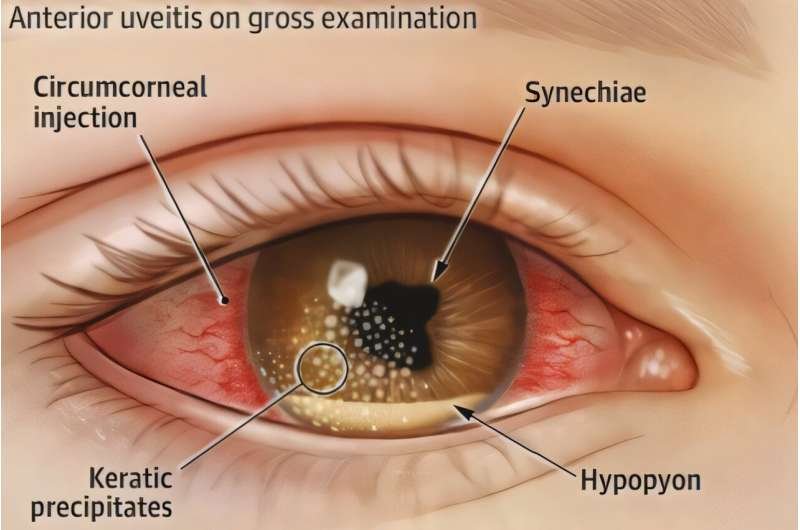
New treatment guidance has been developed to help doctors tackle uveitis—one of the leading causes of vision loss. The new clinical guidance, by a team at the University of Bristol, aims to help thousands of sufferers keep this painful eye condition at bay. The study is published in JAMA.
Typically affecting adults between 20 and 50 years old, the condition, which causes inflammation inside the eye, is responsible for up to 10% of vision loss worldwide. Early detection and treatment are critical for patient recovery.
Despite its impact, this inflammatory disease remains largely unrecognized by the general public and is sometimes overlooked within the wider medical community. A new comprehensive review sheds light on the condition’s causes, symptoms, and the latest advances in treatment, with an urgent call for earlier diagnosis and intervention.
The research, by ophthalmologists at Bristol Medical School, highlights the pressing need for better awareness of uveitis.
A call for earlier diagnosis and better treatment
Dr. Panayiotis Maghsoudlou, NIHR Academic Clinical Lecturer in Ophthalmology at the Bristol Medical School: Translational Health Sciences (THS), and the study’s lead author, emphasized the dangers of late diagnosis, explaining, “Uveitis is often detected too late, by which point irreversible damage may already have occurred. It is vital that people experiencing persistent eye pain, redness, sensitivity to light, new floaters, blurred vision, or sudden changes in sight seek urgent medical attention. Early intervention can significantly improve outcomes, and in many cases, prevent permanent sight loss.
“Diagnosing and treating uveitis is challenging due to the varying presentation of multiple subtypes, each with distinct underlying causes and responses to treatment. This variability complicates both early recognition and the selection of appropriate treatment strategies, as different forms of the disease require tailored approaches.”
To tackle this, the researchers developed new clinical guidance to help doctors diagnose and treat uveitis more effectively. The team conducted an extensive review of 2,900 published studies on uveitis, to evaluate the most effective diagnosis and course of treatment.
New advances in uveitis treatment
Historically, treatment for uveitis has relied on corticosteroids, which help control inflammation but carry risks of long-term side effects such as glaucoma and cataracts. However, recent advancements in treatment have introduced new options, including biologic therapies such as adalimumab, which have proven highly effective for patients with severe or recurrent cases. While these treatments mark a significant step forward, ensuring global access remains a challenge.
The study highlights the importance of a tailored treatment approach, as different types of uveitis require distinct management strategies. While non-infectious uveitis often involves immunosuppressive medications to control inflammation, infectious cases must be treated with targeted antimicrobial therapies.
The need for a multidisciplinary approach
The review underlines the importance of a multidisciplinary approach to managing uveitis, as it is frequently linked to underlying systemic diseases. Collaboration between ophthalmologists, rheumatologists, and infectious disease specialists is essential to ensuring patients receive comprehensive care. The study also calls for greater public health efforts to educate people about uveitis.
Andrew Dick, Professor of Ophthalmology at the Bristol Medical School: THS, and senior author of the study, added, “Despite being a leading cause of preventable blindness, uveitis remains underdiagnosed and undertreated. Our study has identified the most effective treatments depending on the type and cause of the inflammation. By tailoring treatment approaches, we can significantly decrease the likelihood of vision loss, which is the most serious potential outcome of untreated eye inflammation.”
More information:
Panayiotis Maghsoudlou et al, Uveitis in Adults, JAMA (2025). DOI: 10.1001/jama.2025.4358
University of Bristol
Citation:
Early detection is key to improving treatment of uveitis, a global leading cause of vision loss (2025, May 28)
retrieved 29 May 2025
from https://medicalxpress.com/news/2025-05-early-key-treatment-uveitis-global.html
This document is subject to copyright. Apart from any fair dealing for the purpose of private study or research, no
part may be reproduced without the written permission. The content is provided for information purposes only.

